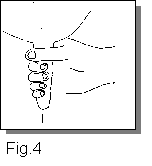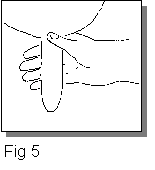|
Home |Saanens
| Anglo Nubians |
Boer Goats | For Sale
| Photos |Raising
Kids | Goat Milk
Producing drinkable milk
First get the milk out of your goat
Hand milking is a skill that is a little difficult to describe in writing. If at all possible try to get some one to demonstrate it to you. The movements are very simple, it just takes practise to put them together in a way that works.
First, make sure the goats udder is clean and dry. Give your hands the same treatment. If there are long hairs on the goats udder and belly, trim them off or they will end up in the milk.
Next, with the forefinger and thumb of one hand, trap a balloon of milk in about the bottom three inches of one of the goats teats. (Fig 1.). If the teats are too short for this, the balloon will have to be shorter. Be firm in your actions or the goat might think she is being tickled!

Now progressively squeeze the finger closest to the forefinger through to the littlest finger down on the trapped balloon of milk (like playing three notes on the piano) and the milk should come out the hole at the bottom of the teat. (Fig.2,3,4). Your aim will probably need improving!



Release the forefinger and thumb to let another lot of milk flow into the bottom of the teat so that you can trap another balloon full and start again.(Fig 5)

When you think you have the technique perfected, be brave and try two hands!
Producing good quality milk
There is little use in going to the effort of milking your goat only to find the milk has a strong taste or goes off after only several days in the fridge. If your milk will not keep for at least 7 days in the fridge (Under 4C) you probably need to improve your milking hygiene. Here are some
tips
- Practice milking smoothly so that you are not knocking loose hair and dirt off the goat into your milking bucket.
-
Keep milking utensils to a bare minimum. The less milking equipment you use the less chance of contamination.
-
Every utensil that touches the milk must be scalded with boiling water immediately prior to use. Alternatively, boil all utensils just before use.
-
Immediately after use, double rinse all utensils in cold water (hot water sets the milk onto the utensils), and then wash them in hot soapy water.
-
Once milking is finished, cool the milk down as quickly as possible or any bacteria in it will begin multiplying quickly. Some ways of doing this are placing the milk container in a bath of cold running water (if you have a plentiful supply), placing the milk container in a bath of iced water, or placing the milk in the freezer for several hours.
Donít forget milk should always be stored under 4C
|




